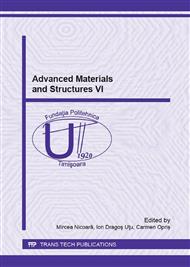[1]
C. Meyer, The greening of the concrete industry, Cem. Concr. Com. 31 (2009) 601-605.
Google Scholar
[2]
P. C. Aitcin, Cements of yesterday and today. Concrete of tomorrow, Cem. Concr. Res. 30 (2000) 1349-1359.
Google Scholar
[3]
G. L. Golewski, Studies of natural radioactivity of concrete with siliceous fly ash addition, Cement-Wapno-Beton [Cement-Lime-Concrete] 2 (2015) 106-114.
Google Scholar
[4]
T. Sadowski, G. L. Golewski, Effect of aggregate kind and graining on modeling of plain concrete under compression, Comput. Mater. Sci. 43 (2008) 119-126.
DOI: 10.1016/j.commatsci.2007.07.037
Google Scholar
[5]
G. L. Golewski, T. Sadowski, An analysis of shear fracture toughness and microstructure in concretes containing fly-ash, Constr. Build. Mater. 51 (2014) 207-214.
DOI: 10.1016/j.conbuildmat.2013.10.044
Google Scholar
[6]
G. L. Golewski, T. Sadowski, Experimental investigation and numerical modelling fracture processes under Mode II in concrete composites containing fly-ash additive at early age, Sol. Stat. Phenom. 188 (2012) 158-163.
DOI: 10.4028/www.scientific.net/ssp.188.158
Google Scholar
[7]
G. L. Golewski, P. Golewski, T. Sadowski, Numerical modeling crack propagation under Mode II fracture in plain concretes containing siliceous fly ash additive using XFEM method, Comput. Mater. Sci. 62 (2012) 75-78.
DOI: 10.1016/j.commatsci.2012.05.009
Google Scholar
[8]
L. Lam, Y. L. Wong, C. S. Poon, Effect of fly ash and silica fume on compressive and fracture behaviors of concrete, Cem. Concr. Res. 28 (1998) 271-283.
DOI: 10.1016/s0008-8846(97)00269-x
Google Scholar
[9]
B. H. Bharatkumar, B. K. Raghuprasad, D. S. Ramachandramurthy, R. Narayanan, S. Gopalakrishnan, Effect of fly ash and slag on the fracture characteristics of high performance concrete, Mater. Struct. 38 (2005) 63-72.
DOI: 10.1007/bf02480576
Google Scholar
[10]
W. C. Tang, T. Y. Lo, W. K. Chan, Fracture properties of normal and lightweight high-strength concrete, Mag. Concr. Res. 60 (2008) 237-244.
DOI: 10.1680/macr.2008.60.4.237
Google Scholar
[11]
E. Vejmelkova et. al., Fly ash influence on the properties of high performance concrete, Cement-Wapno-Beton [Cement-Lime-Concrete] 4 (2009) 189-204.
DOI: 10.32047/cwb.2021.26.5.3
Google Scholar
[12]
J. Roesler, G. H. Paulino, K. Park, C. Gaedicke, Concrete fracture prediction using bilinear softening, Cem. Concr. Com. 29 (2007) 300-312.
DOI: 10.1016/j.cemconcomp.2006.12.002
Google Scholar
[13]
J. Konkol, G. Prokopski, The influence of the age of concretes with FBC fly ash or metakaolinite additives on their strength properties, Roads Bridges 13 (2014) 49-67.
DOI: 10.7409/rabdim.014.004
Google Scholar
[14]
T. Voiconi, E. Linul, L. Marsavina, T. Sadowski, M. Kneć, Determination of flexular properties of rigid PUR foams using digital image correlation, Sol. Stat. Phenom. 216 (2014) 116-121.
DOI: 10.4028/www.scientific.net/ssp.216.116
Google Scholar
[15]
Determination of fracture parameters (KIc and CTODc) of plain concrete using three-point bend tests. RILEM Draft Recommendations, TC 89-FMT Fracture Mechanics of Concrete Test Methods, Mater. Struct. 23 (1990) 457-460.
DOI: 10.1007/bf02472029
Google Scholar
[16]
G. V. Guinea, J. Planas, M. Elices, Measurement of the fracture energy using three point bend tests: Part 1–Influence of experimental procedures, Mater. Struct. 25 (1992) 212-218.
DOI: 10.1007/bf02473065
Google Scholar
[17]
M. Elices, G. V. Guinea, J. Planas, , On the measurement of concrete the fracture energy using three point bend tests, Mater. Struct. 30 (1997) 375-376.
DOI: 10.1007/bf02480689
Google Scholar
[18]
G. Prokopski, B. Langier, Effect of water/cement ratio and silica fume addition on the fracture toughness and morphology of fractured surfaces of gravel concretes, Cem. Conc. Res. 30 (2000) 1427-1433.
DOI: 10.1016/s0008-8846(00)00332-x
Google Scholar
[19]
Z. Wu, H. Rong, J. Zheng, F. Xu, W. Dong, An experimental investigation on the FPZ properties in concrete using digital image correlation technique, Eng. Fract. Mech. 78 (2011) 2978-2990.
DOI: 10.1016/j.engfracmech.2011.08.016
Google Scholar
[20]
Ł. Skarżyński, E. Syroka, J. Tejchman, Measurements and calculations of the width of the fracture process zones on the surface of notched concrete beams, Strain, 47 (2011) e319-e332.
DOI: 10.1111/j.1475-1305.2008.00605.x
Google Scholar
[21]
S. Y. Alam, J. Saliba, A. Loukili, Fracture examination in concrete through combined digital image correlation and acoustic emission techniques, Constr. Build. Mater. 69 (2014) 232-242.
DOI: 10.1016/j.conbuildmat.2014.07.044
Google Scholar
[22]
A. Bascoul, A. Turatsinze, Microstructural characterization of mode I crack opening in mortar, Mater. Struct. 27 (1994) 71-78.
DOI: 10.1007/bf02472824
Google Scholar
[23]
T. Sadowski, Modelling of semi-brittle ceramic behaviour under compression state, Mech. Mater. 18 (1994) 1-16.
Google Scholar
[24]
G. Golewski, T. Sadowski, Fracture toughness at shear (mode II) of concretes made of natural and broken aggregates, In: The Eight International Symposium on Brittle Matrix Composites, 2006 537-546.
DOI: 10.1533/9780857093080.537
Google Scholar
[25]
G. Golewski, T. Sadowski, Rola kruszywa grubego w procesie destrukcji kompozytów betonowych poddanych obciążeniom doraźnym [The role of coarse aggregate in failure process of concrete composites subjected short-time loads], IZT, Lublin, 2008 (in Polish).
Google Scholar
[26]
T. Sadowski, L. Marsavina, Multiscale modelling of two-phase ceramic matrix composites, Comput. Mat. Sci. 50 (2011) 1336-1346.
DOI: 10.1016/j.commatsci.2010.04.011
Google Scholar
[27]
T. Sadowski, Gradual degradation in two-phase ceramic composites under compression, Comput. Mat. Sci. 64 (2012), 209-211.
DOI: 10.1016/j.commatsci.2012.01.034
Google Scholar
[28]
E. Postek, T. Sadowski, Assessing the influence of porosity in the deformation of metal-ceramic composites, Comp. Inter. 18 (2011) 57-76.
DOI: 10.1163/092764410x554049
Google Scholar
[29]
T. Sadowski, S. Samborski, Development of damage state in porous ceramics under compression, Comp. Mater. Sci. 43 (2008) 75-81.
DOI: 10.1016/j.commatsci.2007.07.041
Google Scholar
[30]
T. Sadowski, S. Samborski, Modelling of porous ceramics response to compressive loading, J. Am. Cer. Soc. 86 (2003) 2218-2221.
DOI: 10.1111/j.1151-2916.2003.tb03637.x
Google Scholar
[31]
M. Birsan, T. Sadowski, D. Pietras, Thermoelastic deformations of cylindrical multi-layered shells using a direct approach, J. Therm. Str. 36 (2013) 1-38.
DOI: 10.1080/01495739.2013.764802
Google Scholar
[32]
T. Sadowski, M. Birsan, D. Pietras, Numerical analysis of multilayered and FGM structural elements under mechanical and thermal loads. Comparison of the finite elements and analytical models, Arch. Civ. Mech. Eng. 15 (2015) 1180-1192.
DOI: 10.1016/j.acme.2014.09.004
Google Scholar
[33]
T. Sadowski, B. Pankowski, Numerical modelling of two-phase ceramic composite response under uniaxial loading, Compos. Struct. 143 (2016) 388-394.
DOI: 10.1016/j.compstruct.2016.02.022
Google Scholar


